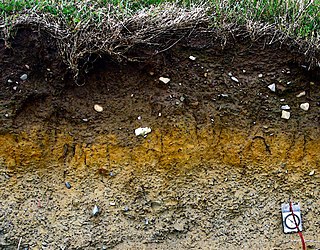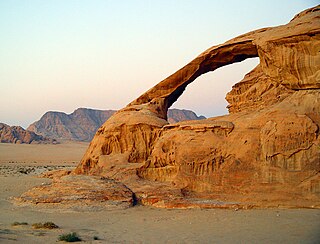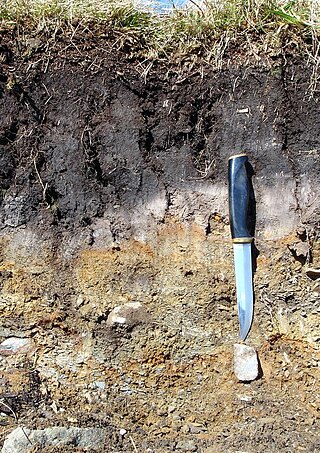Related Research Articles

In classical soil science, humus is the dark organic matter in soil that is formed by the decomposition of plant and animal matter. It is a kind of soil organic matter. It is rich in nutrients and retains moisture in the soil. Humus is the Latin word for "earth" or "ground".

Soil, also commonly referred to as earth, is a mixture of organic matter, minerals, gases, liquids, and organisms that together support life of plants and soil organisms. Some scientific definitions distinguish dirt from soil by restricting the former term specifically to displaced soil.

Weathering is the deterioration of rocks, soils and minerals as well as wood and artificial materials through contact with water, atmospheric gases, and biological organisms. Weathering occurs in situ, and so is distinct from erosion, which involves the transport of rocks and minerals by agents such as water, ice, snow, wind, waves and gravity.

Soil pH is a measure of the acidity or basicity (alkalinity) of a soil. Soil pH is a key characteristic that can be used to make informative analysis both qualitative and quantitatively regarding soil characteristics. pH is defined as the negative logarithm (base 10) of the activity of hydronium ions in a solution. In soils, it is measured in a slurry of soil mixed with water, and normally falls between 3 and 10, with 7 being neutral. Acid soils have a pH below 7 and alkaline soils have a pH above 7. Ultra-acidic soils and very strongly alkaline soils are rare.
USDA soil taxonomy (ST) developed by the United States Department of Agriculture and the National Cooperative Soil Survey provides an elaborate classification of soil types according to several parameters and in several levels: Order, Suborder, Great Group, Subgroup, Family, and Series. The classification was originally developed by Guy Donald Smith, former director of the U.S. Department of Agriculture's soil survey investigations.
The pedosphere is the outermost layer of the Earth that is composed of soil and subject to soil formation processes. It exists at the interface of the lithosphere, atmosphere, hydrosphere and biosphere. The pedosphere is the skin of the Earth and only develops when there is a dynamic interaction between the atmosphere, biosphere, lithosphere and the hydrosphere. The pedosphere is the foundation of terrestrial life on Earth.

In soil science, podzols are the typical soils of coniferous or boreal forests and also the typical soils of eucalypt forests and heathlands in southern Australia. In Western Europe, podzols develop on heathland, which is often a construct of human interference through grazing and burning. In some British moorlands with podzolic soils, cambisols are preserved under Bronze Age barrows.
A soil horizon is a layer parallel to the soil surface whose physical, chemical and biological characteristics differ from the layers above and beneath. Horizons are defined in many cases by obvious physical features, mainly colour and texture. These may be described both in absolute terms and in terms relative to the surrounding material, i.e. 'coarser' or 'sandier' than the horizons above and below.

Brown earth is a type of soil. Brown earths are mostly located between 35° and 55° north of the Equator. The largest expanses cover western and central Europe, large areas of western and trans-Uralian Russia, the east coast of America and eastern Asia. Here, areas of brown earth soil types are found particularly in Japan, Korea, China, eastern Australia and New Zealand. Brown earths cover 45% of the land in England and Wales. They are common in lowland areas on permeable parent material. The most common vegetation types are deciduous woodland and grassland. Due to the reasonable natural fertility of brown earths, large tracts of deciduous woodland have been cut down and the land is now used for farming. They are normally located in regions with a humid temperate climate. Rainfall totals are moderate, usually below 76 cm per year, and temperatures range from 4 °C in the winter to 18 °C in the summer. They are well-drained fertile soils with a pH of between 5.0 and 6.5.
Soil chemistry is the study of the chemical characteristics of soil. Soil chemistry is affected by mineral composition, organic matter and environmental factors. In the early 1870s a consulting chemist to the Royal Agricultural Society in England, named J. Thomas Way, performed many experiments on how soils exchange ions, and is considered the father of soil chemistry. Other scientists who contributed to this branch of ecology include Edmund Ruffin, and Linus Pauling.
Brown podzolic soils are a subdivision of the Podzolic soils in the British soil classification. Although classed with podzols because they have an iron-rich, or spodic horizon, they are, in fact intermediate between podzols and Brown earths. They are common on hilly land in western Europe, in climates where precipitation of more than about 900mm exceeds evapotranspiration for a large part of the year, and summers are relatively cool. The result is that leaching of the soil profile occurs; in which mobile chemicals are washed out of the topsoil, or A horizon, and accumulate lower down, in the B horizon.
The Canadian System of Soil Classification is more closely related to the American system than any other, but they differ in several ways. The Canadian system is designed to cover only Canadian soils. The Canadian system dispenses with the sub-order hierarchical level. Solonetzic and Gleysolic soils are differentiated at the order level.
Ferrallitisation is the process in which rock is changed into a soil consisting of clay (kaolinite) and sesquioxides, in the form of hydrated oxides of iron and aluminium. In humid tropical areas, with consistently high temperatures and rainfall for all or most of the year, chemical weathering rapidly breaks down the rock. This at first produces clays which later also break down to form silica. The silica is removed by leaching and the sesquioxides of iron and aluminium remain, giving the characteristic red colour of many tropical soils. Ferrallitisation is the reverse of podsolisation, where silica remains and the iron and aluminum are removed. In tropical rain forests with rain throughout the year, ferrallitic soils develop. In savanna areas, with altering dry and wet climates, ferruginous soils occur.

Alkali, or Alkaline, soils are clay soils with high pH, a poor soil structure and a low infiltration capacity. Often they have a hard calcareous layer at 0.5 to 1 metre depth. Alkali soils owe their unfavorable physico-chemical properties mainly to the dominating presence of sodium carbonate, which causes the soil to swell and difficult to clarify/settle. They derive their name from the alkali metal group of elements, to which sodium belongs, and which can induce basicity. Sometimes these soils are also referred to as alkaline sodic soils.
Alkaline soils are basic, but not all basic soils are alkaline.

Red soil is a type of soil that typically develops in warm, temperate, and humid climates and comprise approximately 13% of Earth's soils. It contains thin organic and organic-mineral layers of highly leached soil resting on a red layer of alluvium. Red soils contain large amounts of clay and are generally derived from the weathering of ancient crystalline and metamorphic rock. They are named after their rich red color, which can vary from reddish brown to reddish yellow as a result of their high iron content. Red soil can be good or poor growing soil depending on how it is managed. It is usually low in nutrients and humus and can be difficult to cultivate due to its low water holding capacity; however, the fertility of these soils can be optimized with liming and other farming techniques.
Latosols, also known as tropical red earth, are soils found under tropical rainforests which have a relatively high content of iron and aluminium oxides. They are typically classified as oxisols or ferralsols. Latosols are tropical soils, but not all soils in the tropics are latosolic. Latosols are red or yellowish-red in colour throughout and they do not have distinct horizons like a podsol. The red colour comes from the iron oxides in the soil. They are deep soils, often extending 20–30 m (66–98 ft) deep whereas podsols are 1–2 m deep.

Laterite is both a soil and a rock type rich in iron and aluminium and is commonly considered to have formed in hot and wet tropical areas. Nearly all laterites are of rusty-red coloration, because of high iron oxide content. They develop by intensive and prolonged weathering of the underlying parent rock, usually when there are conditions of high temperatures and heavy rainfall with alternate wet and dry periods. Tropical weathering (laterization) is a prolonged process of chemical weathering which produces a wide variety in the thickness, grade, chemistry and ore mineralogy of the resulting soils. The majority of the land area containing laterites is between the tropics of Cancer and Capricorn.
The soil matrix is the solid phase of soils, and comprise the solid particles that make up soils. Soil particles can be classified by their chemical composition (mineralogy) as well as their size. The particle size distribution of a soil, its texture, determines many of the properties of that soil, in particular hydraulic conductivity and water potential, but the mineralogy of those particles can strongly modify those properties. The mineralogy of the finest soil particles, clay, is especially important.

Mor humus is a form of forest floor humus occurring mostly in coniferous forests. Mor humus consists of evergreen needles and woody debris that litter the forest floor. This litter is slow to decompose, in part due to their chemical composition, but also because of the generally cool and wet conditions where mor humus is found. This results in low bacterial activity and an absence of earthworms and other soil fauna. Because of this, most of the organic matter decomposition in mor humus is carried out by fungi.
The term humus form is not the same as the term humus. Forest humus form describes the various arrangement of organic and mineral horizons at the top of soil profiles. It can be composed entirely of organic horizons, meaning an absence of the mineral horizon. Experts worldwide have developed different types of classifications over time, and humus forms are mainly categorized into mull, mor, and moder orders in the ecosystems of British Columbia. Mull humus form is distinguishable from the other two forms in formation, nutrient cycling, productivity, etc.
References
- ↑ Encyclopedia of Soils in the Environment, 2005
- ↑ Rode A. A. To the problem of the degree of podzolization of soils // Studies in the genesis and geography of soils. M.: Acad. Sci. USSR, 1935. P. 55-70.
- ↑ Fritz., Scheffer (2010). Lehrbuch der Bodenkunde. Schachtschabel, Paul., Blume, Hans-Peter (16. Aufl ed.). Heidelberg: Spektrum, Akad. Verl. ISBN 9783827414441. OCLC 506415938.